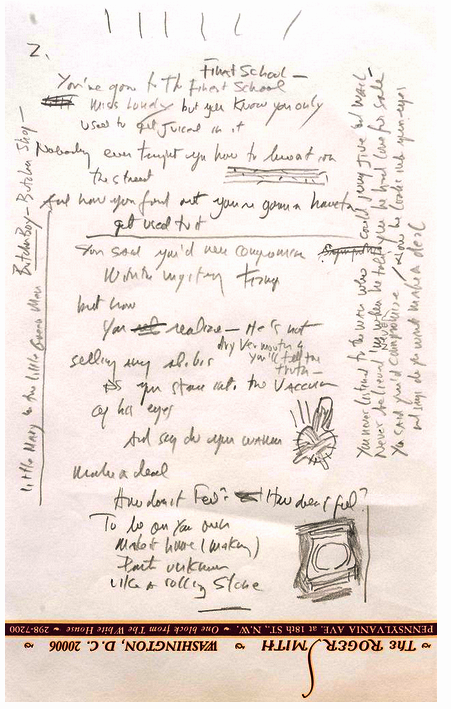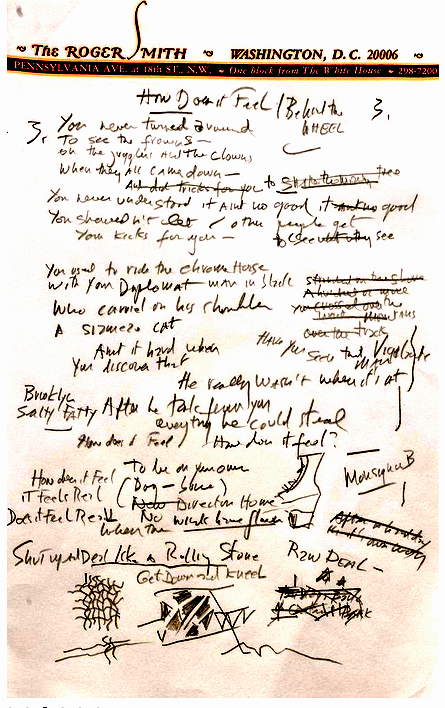
Oh to have been a fly on the wall as Bob Dylan wrote some of his now classic songs.
Until time travel becomes possible, the closest we may get to observing Dylan the songwriter in action are the four pages from the working manuscript for “Like A Rolling Stone” that Sotheby’s will auction on June 24, 2014 in New York.
On the pages, along with many of the lines that ended up in what some believe is Dylan’s greatest song, a song that certainly changed people’s ideas of what rock ‘n’ roll could be upon it’s release in July of 1965, are lyrics that Dylan clearly was considering for inclusion, but which didn’t make the cut.
The chorus, for instance, didn’t fully come together until page four of the manuscript. On page one there is a version of the chorus that reads:
“How does it feel
How does it feel
To be (or not to be) on your own
Direction (road back home)
Like a complete unknown, like a rolling stone.”
Right below the second “How does it feel,” Dylan has added “Is it ain’t quite real.”
And at the side of the page it says “Al Capone” with a line drawn to the word “direction” in the chorus.

On the second page of the manuscript is a version of the chorus with “path unknown” as one of the lines.
At the top of page three is written: “How does it feel/ Behind the wheel.”
At the bottom of page three the chorus is again a work in progress:
How does it feel to be on your own
It feels real (dog-bone)
Does it feel real.”
Then he wrote “New direction home” but put a line through “new” and wrote “no” under it.
Then: “When the winds have (unreadable word that could be “flown”)
“Shut up and deal like a rolling stone
Raw deal
Get down and kneel.”

By page four this is the chorus:
“How does it feel, how does it feel
To be on your own
Like a dog without a bone
Now you’re unknown
Forever complete unknown
New direction home
No direction home
Like a rolling stone.”
“If you look at these four pages, you can see that at this stage there are rhyme schemes that he didn’t pursue, and I suppose the chorus is the biggest surprise,” Richard Austin, Sotheby’s manuscript expert, told the New York Times. “Here you have a chorus that is such an iconic piece of history, but it clearly didn’t arrive fully formed. And you wonder, if he chose another rhyme, would it have had the same impact?”
Dylan has written names of songs and books on the pages, which may or may not relate to the song itself: “Pony Blues,” a song by Charley Patton; “Midnight Special” (and above it “Mavis”); “On the Road”; and “Butcher Boy,” which likely refers to “The Butcher Boy,” an old folk song that the Clancy Brothers recorded.
“It was ten pages long,” Dylan once said of the manuscript for “Like A Rolling Stone.” “It wasn’t called anything, just a rhythm thing on paper all about my steady hatred directed at some point that was honest. In the end it wasn’t hatred, it was telling someone something they didn’t know, telling them they were lucky.”

There’s also a mostly discarded verse that reads:
“You never listened to the man who could (illegible) jive and wail
Never believed ‘m when he told you he had love for sale
You said you’d never compromise/ now he looks into your eyes
and says do you want make a deal.”
And what ended up being the third verse reads like this in part:
“You never turned around
To see the frowns
On the jugglers and the clowns
When they all came down
And did tricks for you to shake the money tree.”
There’s a line drawn through that entire last line.
The four manuscript pages for “Like A Rolling Stone” could sell for as much as $2 million.
Get the back story from the New York Times and Rolling Stone.
Dylan singing “Like A Rolling Stone”:
– A Days of the Crazy-Wild blog post: sounds, visuals and/or news –-
1 thought on “Secrets of ‘Like A Rolling Stone’ Revealed in Dylan’s Working Manuscript for the Song”